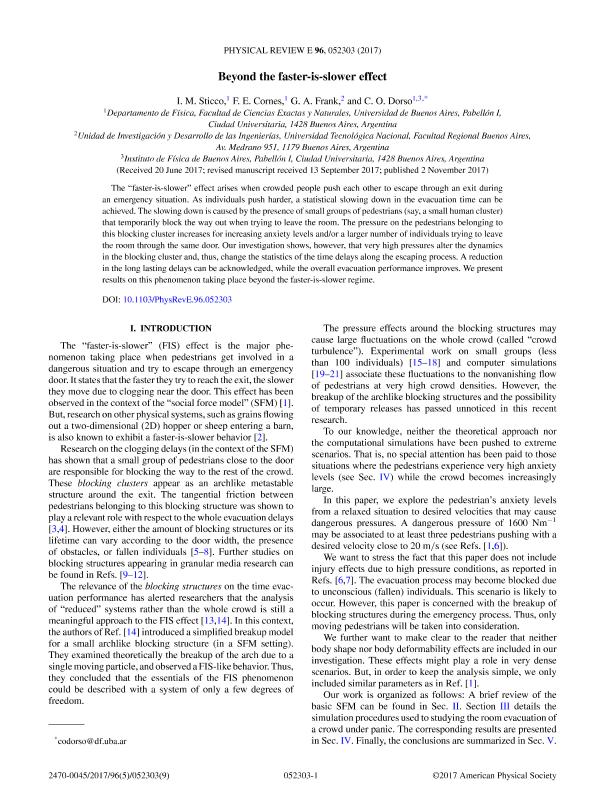Artículo
Beyond the faster-is-slower effect
Sticco, Ignacio Mariano ; Cornes, Fernando Ezequiel
; Cornes, Fernando Ezequiel ; Frank, Guillermo Alberto
; Frank, Guillermo Alberto ; Dorso, Claudio Oscar
; Dorso, Claudio Oscar
 ; Cornes, Fernando Ezequiel
; Cornes, Fernando Ezequiel ; Frank, Guillermo Alberto
; Frank, Guillermo Alberto ; Dorso, Claudio Oscar
; Dorso, Claudio Oscar
Fecha de publicación:
11/2017
Editorial:
American Physical Society
Revista:
Physical Review E
ISSN:
2470-0053
Idioma:
Inglés
Tipo de recurso:
Artículo publicado
Clasificación temática:
Resumen
The "faster-is-slower" effect arises when crowded people push each other to escape through an exit during an emergency situation. As individuals push harder, a statistical slowing down in the evacuation time can be achieved. The slowing down is caused by the presence of small groups of pedestrians (say, a small human cluster) that temporarily block the way out when trying to leave the room. The pressure on the pedestrians belonging to this blocking cluster increases for increasing anxiety levels and/or a larger number of individuals trying to leave the room through the same door. Our investigation shows, however, that very high pressures alter the dynamics in the blocking cluster and, thus, change the statistics of the time delays along the escaping process. A reduction in the long lasting delays can be acknowledged, while the overall evacuation performance improves. We present results on this phenomenon taking place beyond the faster-is-slower regime.
Palabras clave:
Active Mattera
,
Pedestrian Simulation
Archivos asociados
Licencia
Identificadores
Colecciones
Articulos(IFIBA)
Articulos de INST.DE FISICA DE BUENOS AIRES
Articulos de INST.DE FISICA DE BUENOS AIRES
Articulos(SEDE CENTRAL)
Articulos de SEDE CENTRAL
Articulos de SEDE CENTRAL
Citación
Sticco, Ignacio Mariano; Cornes, Fernando Ezequiel; Frank, Guillermo Alberto; Dorso, Claudio Oscar; Beyond the faster-is-slower effect; American Physical Society; Physical Review E; 96; 5; 11-2017; 1-9
Compartir
Altmétricas



